
The Crucial T700 sets a new bar in performance for consumer SSDs, pushing speed higher than any other PCIe 5.0 NVMe drive on the market. It reigns as the king of the hill for sequential bandwidth and random IOPS, at least for now. Its native DirectStorage firmware optimization is an added benefit over almost all PCIe 4.0 SSDs for future gaming, as well. Crucial departs from the reference heatsink design with its own effective solution while also offering a cheaper, bare-drive variant for easier installation with motherboard and custom M.2 heatsinks. Together, this makes it a nice option for enthusiasts and early adopters.
The T700 is part of a wave of PCIe 5.0 SSDs about to deluge the consumer SSD market, all so far based on the same Phison E26 controller and Micron flash. This puts pressure on the manufacturers to differentiate their products in other ways, particularly with cooling. This could bring some innovation to the market, but current industry trends have created lingering concerns about the future of NAND that could eventually reduce the buyer’s pricing advantage from such competition.
Competing controllers are also on the way with InnoGrit’s IG5666 and SMI’s SM2508, and flash of the 232-Layer generation should be in wider production from Micron and other manufacturers. Faster drives based on the Phison E26 SSD Controller have also been announced offering up to 14 GBps, so early drives like the T700 have a limited window to shine. We’ll know more after Computex, which is currently underway, but many of these drives won’t be available until later in the year. At the time of review, this drive is the fastest of its crop.
Specifications
The Crucial T700 is available at 1TB, 2TB, and 4TB capacities in both bare and heatsinked variants with MSRPs of $179.99/$209.99, $339.99/$369.99, and $599.99/$629.99, respectively. This is a significant premium over slower PCIe 5.0 SSDs like the heatsinked Inland TD510, where the 2TB model can be had for $249.99 at the time of review. It’s likely that the T700’s price will come down some time after launch, but these prices are what Crucial currently lists on its store.
Let's also be clear that paying $30 extra for the small metal heatsink is asking far too much. If you have a motherboard with a decent M.2 heatsink, you should just get that model. The included heatsink does work fine in our testing, but a $10 premium would be more in line with what you're getting.
The T700 is capable of reaching 12,400 MBps / 11,800 MBps for sequential reads and writes and 1,500 million IOPS for both random reads and writes. The primary benefit over slower PCIe 5.0 SSD variants is the sequential performance increase, but write IOPS are also higher. Crucial warranties this drive for the typical 600TB written per TB of capacity at up to five years. The retail drive has TCG Opal 2.01 support for encryption, which was not enabled in our previous Crucial T700 Preview.
Software and Accessories
Crucial offers its own SSD toolbox called the Crucial Storage Executive, which has the typical features you would expect. This includes drive information, SMART attributes, firmware updates, secure erase/sanitize, overprovisioning, and other features related to encryption. Third-party software like CloneZilla is recommended for cloning and imaging.
A Closer Look

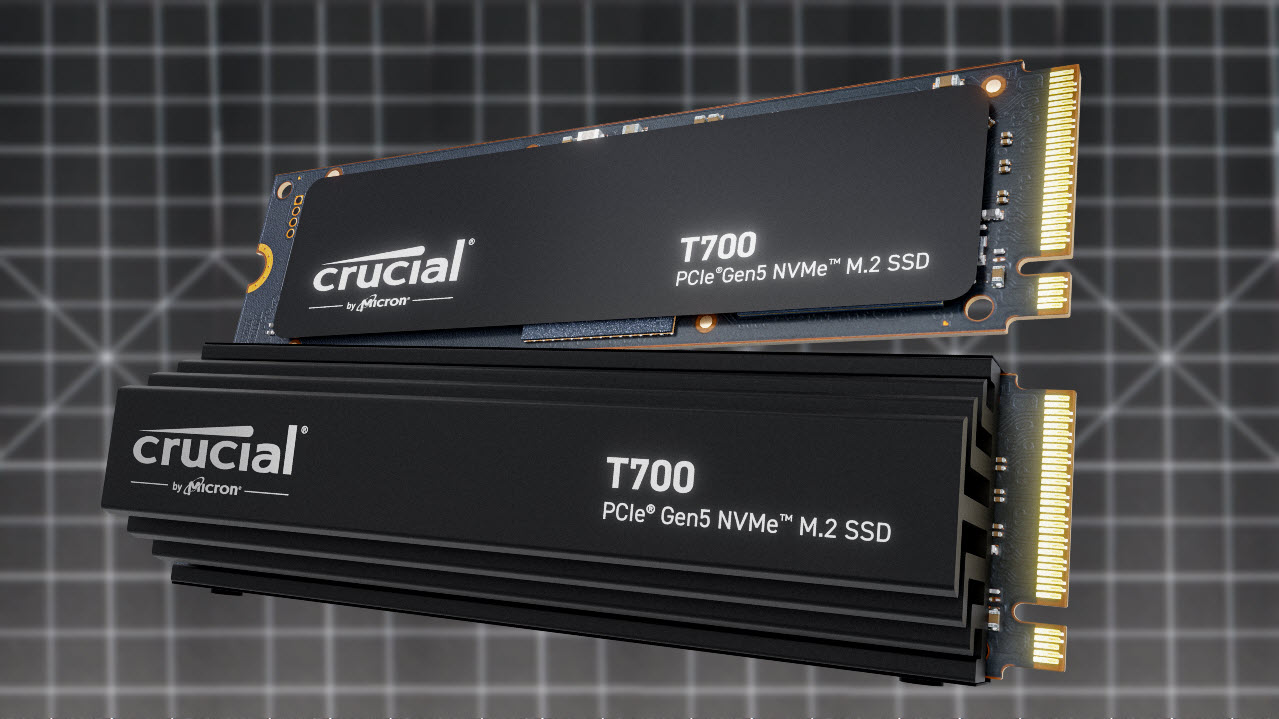
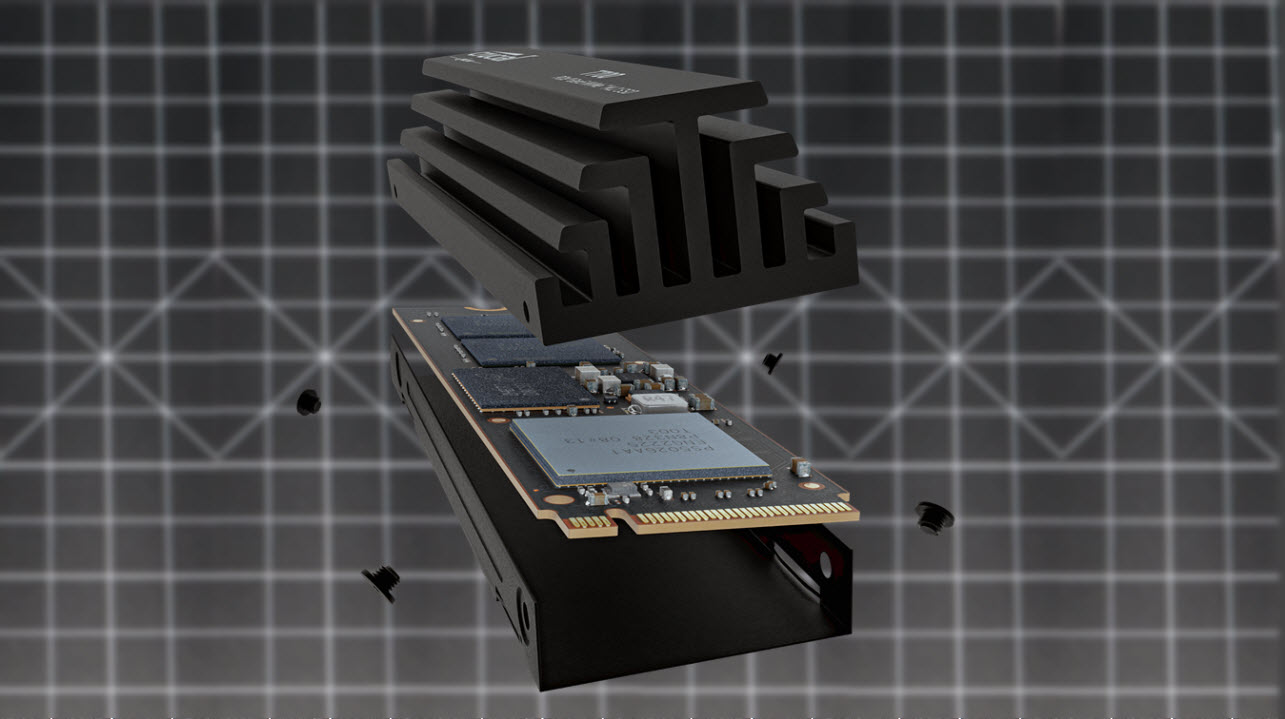
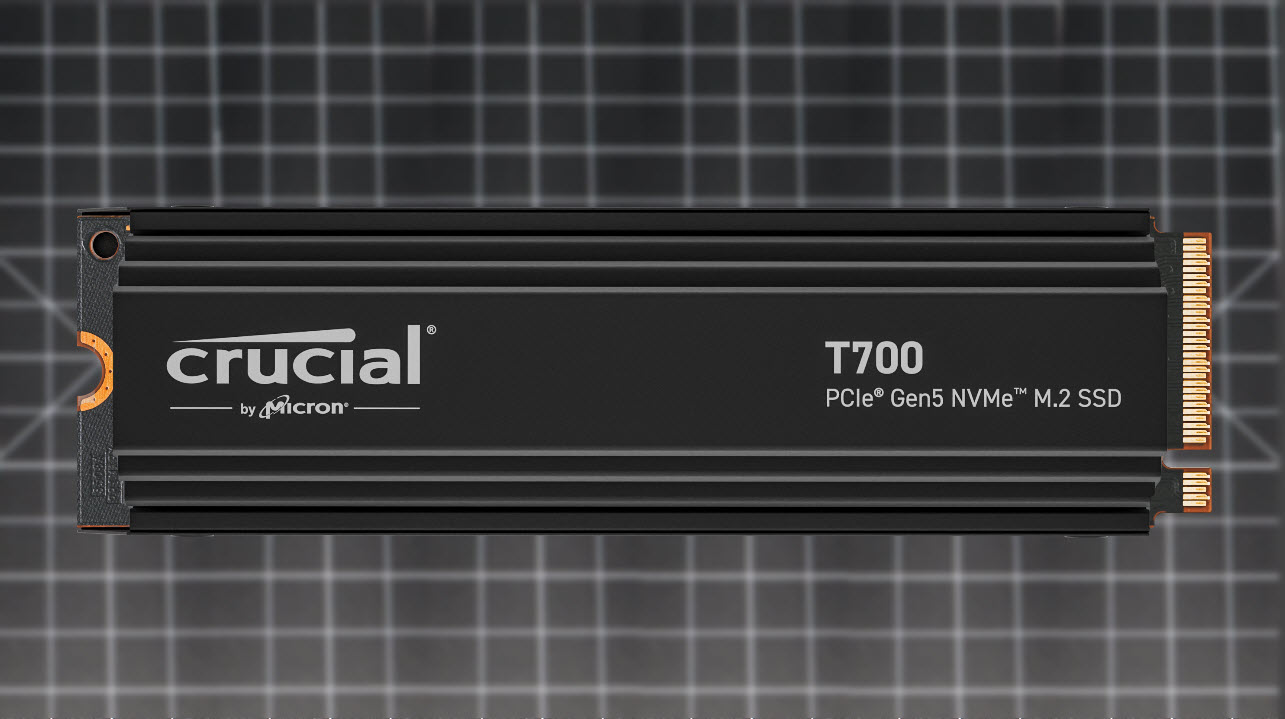
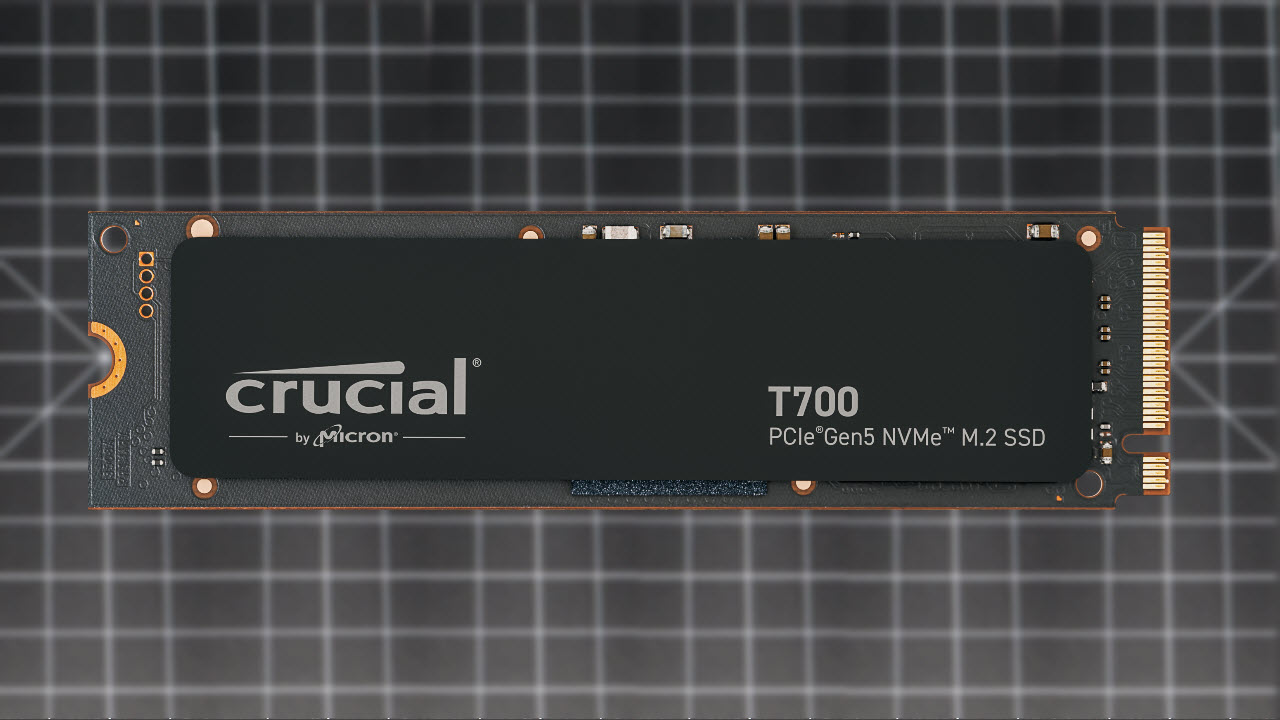
The Crucial T700 can be purchased with or without its custom, passive heatsink. The heatsink is carefully designed to avoid the need for a fan, using a variety of materials and an airflow-optimized shape. The backplate makes it usable in motherboards that have flush thermal padding, which can be removed for this drive.
The non-heatsinked variant of the drive comes with a label that should not be removed, and the drive should not be operated without sufficient cooling applied. Such cooling would include a motherboard’s M.2 heatsink or your own aftermarket solution. The drive should not be used bare in the PlayStation 5 or in a laptop.
The drive itself has an SSD controller, one DRAM package, and two NAND packages on the top side. The rear side has two more NAND packages for a total of four. There's also a power management integrated circuit, or PMIC, labeled Phison.

The T700 utilizes Phison’s E26 SSD controller, an 8-channel design capable of running a bus speed of up to 2400 MT/s to help saturate four lanes of PCIe 5.0 connectivity. Initial E26 drives top out around 10 GBps at 1600 MT/s, but Crucial has opted for 2000 MT/s here. Future drives, some of which have been already announced, will push 2400 MT/s for 14 GBps or more. Higher speeds put more stress on the hardware, so cooling becomes more critical, especially with sustained workloads.
The 2TB T700 comes with 32Gb, or 4GB, of LPDDR4. This is more than enough memory even for the 4TB SKU. LPDDR4 is more power-efficient than DDR4 but the impact is not enough to help keep the E26 solution from being very power-hungry.
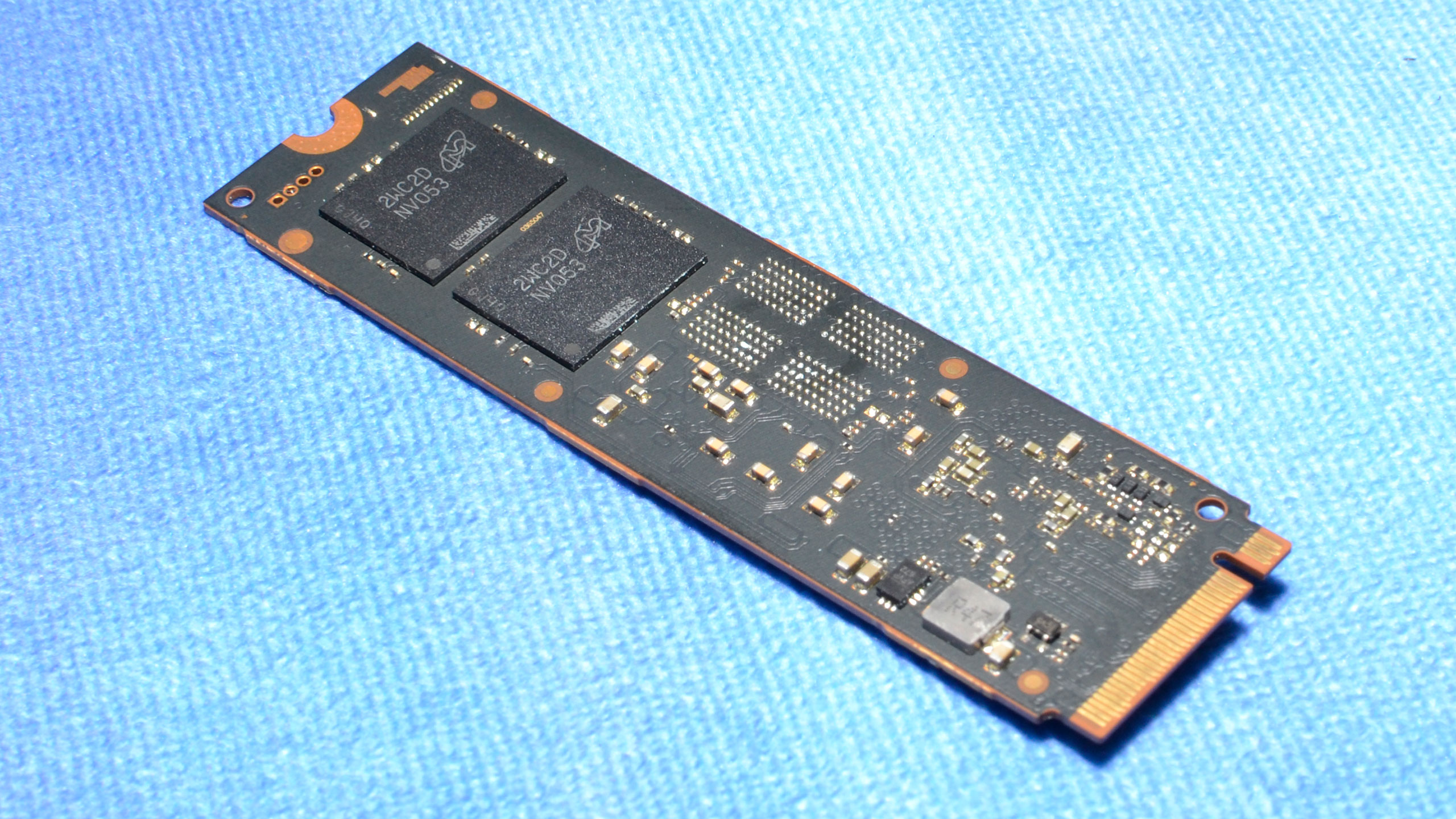
The flash is Micron’s 232-Layer TLC, or B58R, capable of running at 1600-2400 MT/s. This hexa-plane flash comes in 1Tb dies, so each 512GB package has four dies for a total of sixteen. Given the E26’s 8-channel design, it’s therefore possible that peak performance will be realized at the 4TB capacity.
MORE: Best SSDs
MORE: Best External SSDs and Hard Drives
MORE: How We Test HDDs And SSDs
MORE: All SSD Content
Comparison Products
The 2TB Crucial T700 SSD is tested both with Crucial’s heatsink (labeled "HS" in the charts) and with out Asus motherboard’s heatsink (labeled "(Mobo)" in the charts). It’s up against other current PCIe 5.0 SSDs including the Corsair MP700, the Gigabyte Aorus Gen5 10000, the Inland TD510, and we also have results from the engineering sample (ES) Phison E26. The high-end PCIe 4.0 drives in our charts include the Adata Legend 960 Max, Crucial P5 Plus, Sabrent Rocket 4 Plus-G, Samsung 990 Pro, and Solidigm P44 Pro.
Trace Testing - 3DMark Storage Benchmark
Built for gamers, 3DMark’s Storage Benchmark focuses on real-world gaming performance. Each round in this benchmark stresses storage based on gaming activities including loading games, saving progress, installing game files, and recording gameplay video streams.


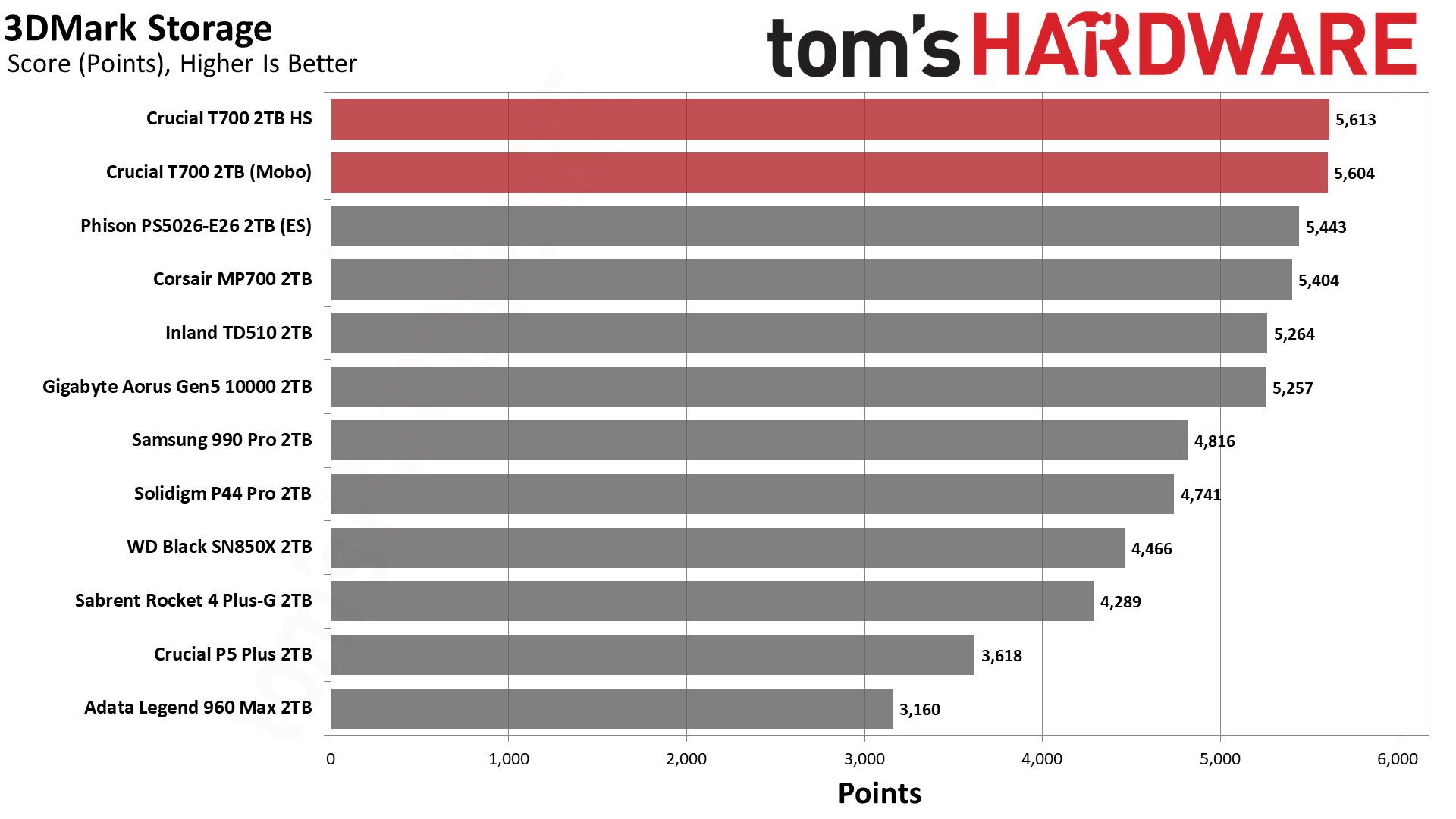
The T700 is the fastest drive we’ve tested to date in 3DMark. The performance improvement over other PCIe 5.0 SSDs is a modest 4~7 percent, with a larger gap between the T700 and leading 4.0 options.
Speaking of gaming, drives using the E26 SSD controller come with Phison’s I/O+ firmware for DirectStorage optimization, which is only available on one PCIe 4.0 SSD, the Sabrent Rocket 4 Plus-G. Faster drives should be out by the time that makes a real impact, however.
Trace Testing – PCMark 10 Storage Benchmark
PCMark 10 is a trace-based benchmark that uses a wide-ranging set of real-world traces from popular applications and everyday tasks to measure the performance of storage devices.
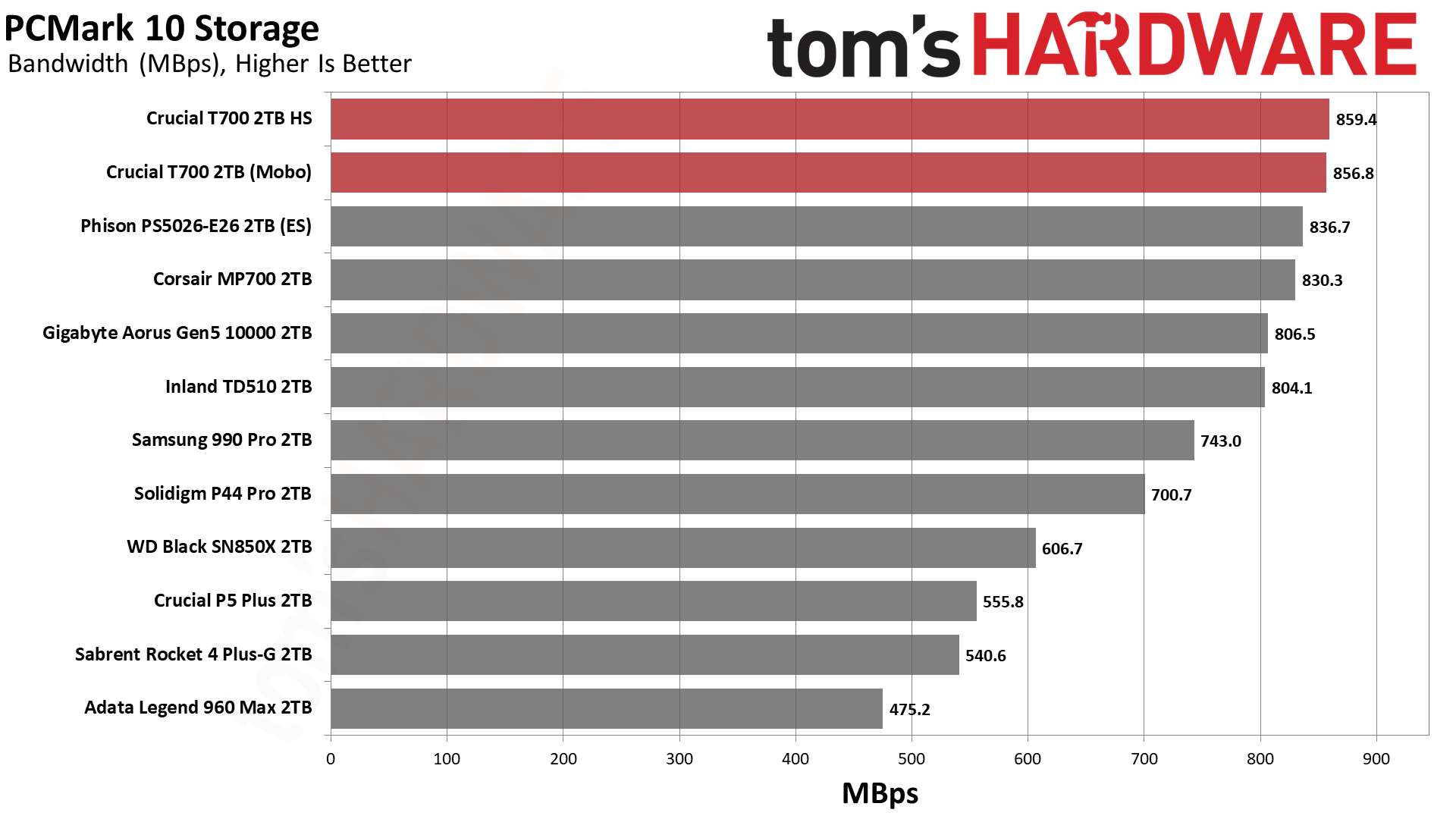
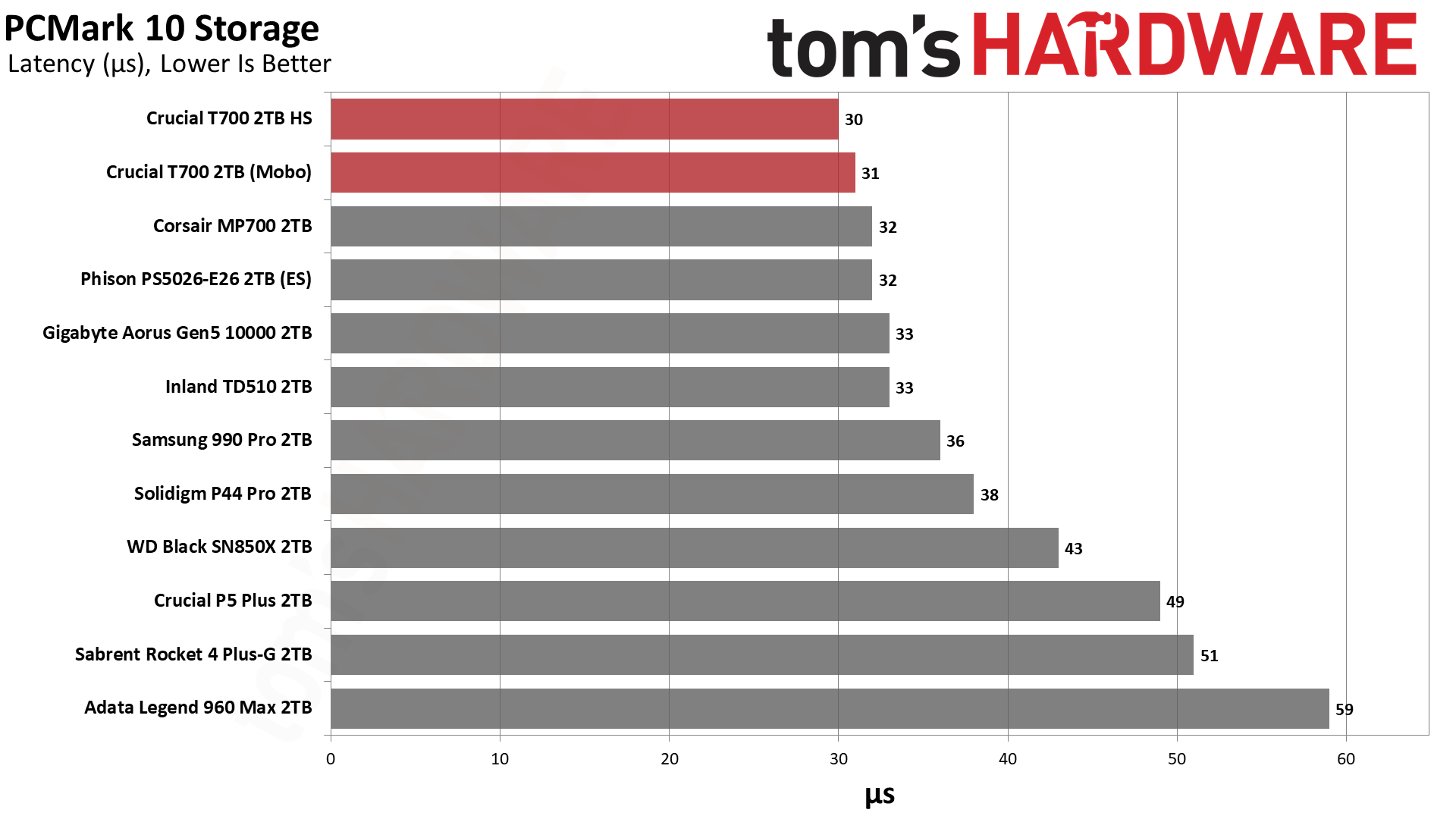

PCMark 10 shows a similar pattern with the T700 again on top. The real-world differences between the top drives are very small, especially among the PCIe 5.0 models, but the slightly higher transfer speeds do push Crucial to the top.
Transfer Rates – DiskBench
We use the DiskBench storage benchmarking tool to test file transfer performance with a custom, 50GB dataset. We copy 31,227 files of various types, such as pictures, PDFs, and videos to a new folder and then follow-up with a reading test of a newly-written 6.5GB zip file.
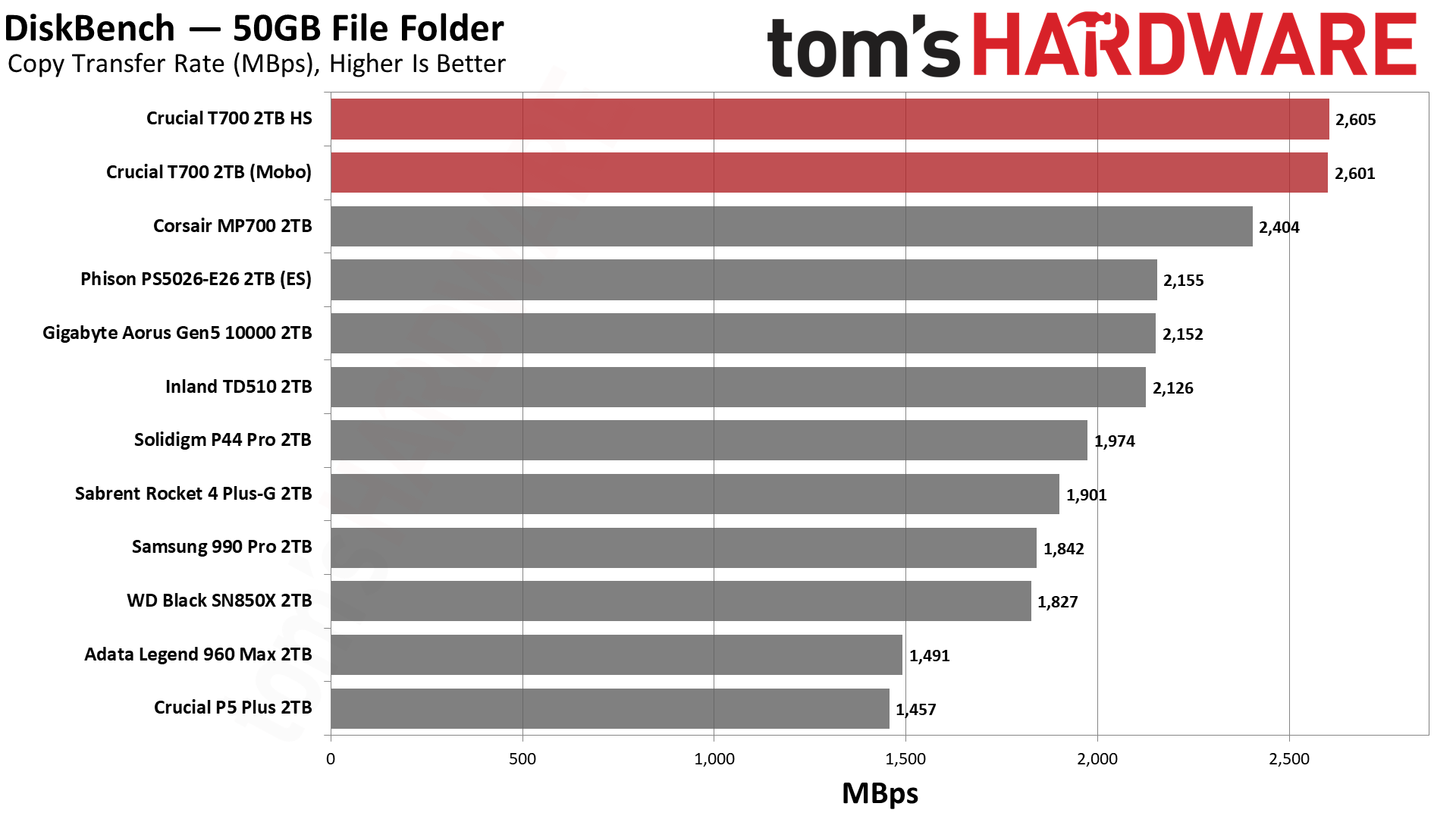
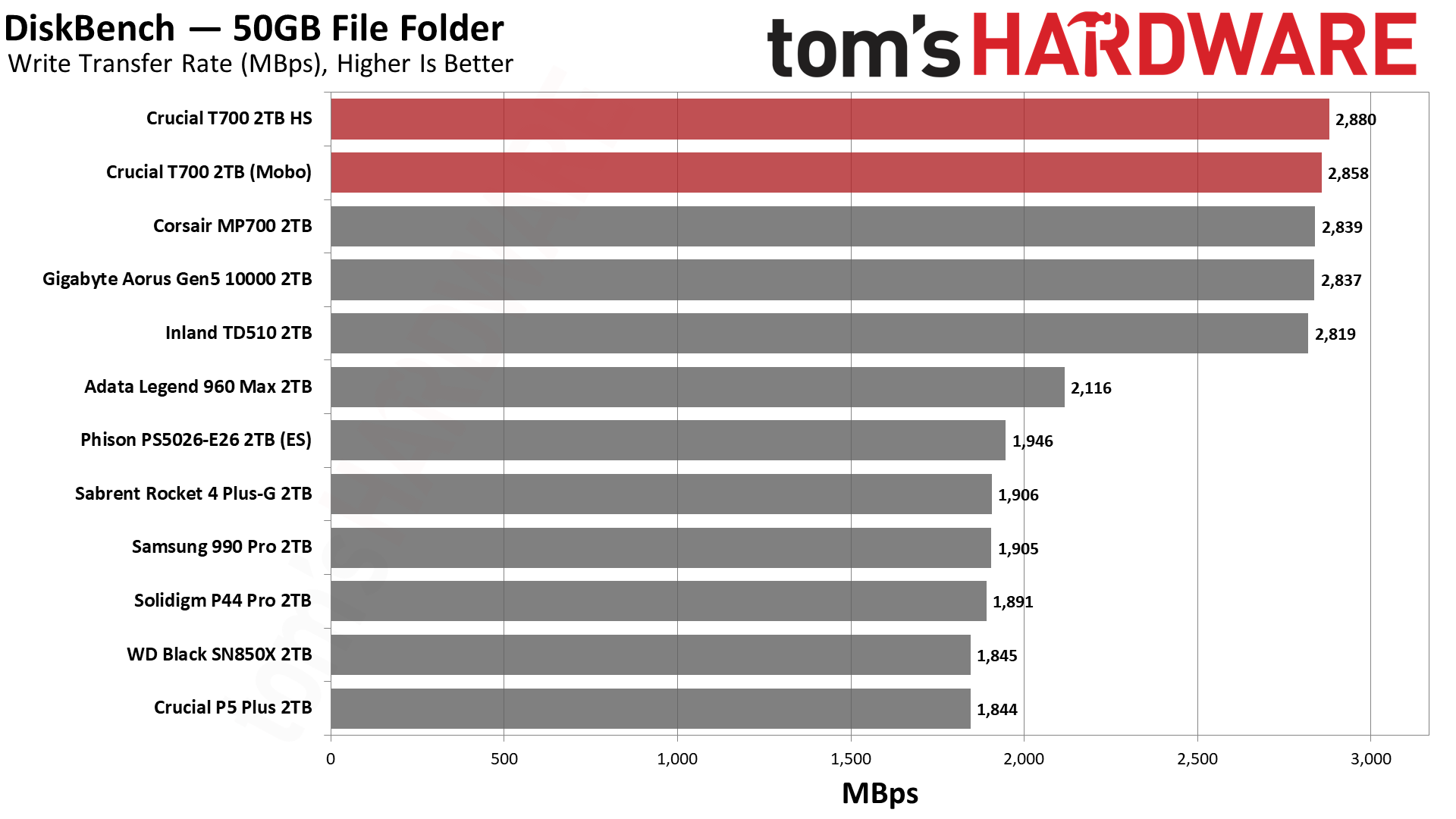

Copy speeds in DiskBench are faster, with significant gains over previously-tested drives. The main reason to buy PCIe 5.0 drives right now is for this type of performance if you are capable of making use of it — meaning, you have a Z690/Z790 or X670 class motherboard.
Synthetic Testing - ATTO / CrystalDiskMark
ATTO and CrystalDiskMark (CDM) are free and easy-to-use storage benchmarking tools that SSD vendors commonly use to assign performance specifications to their products. Both of these tools give us insight into how each device handles different file sizes.

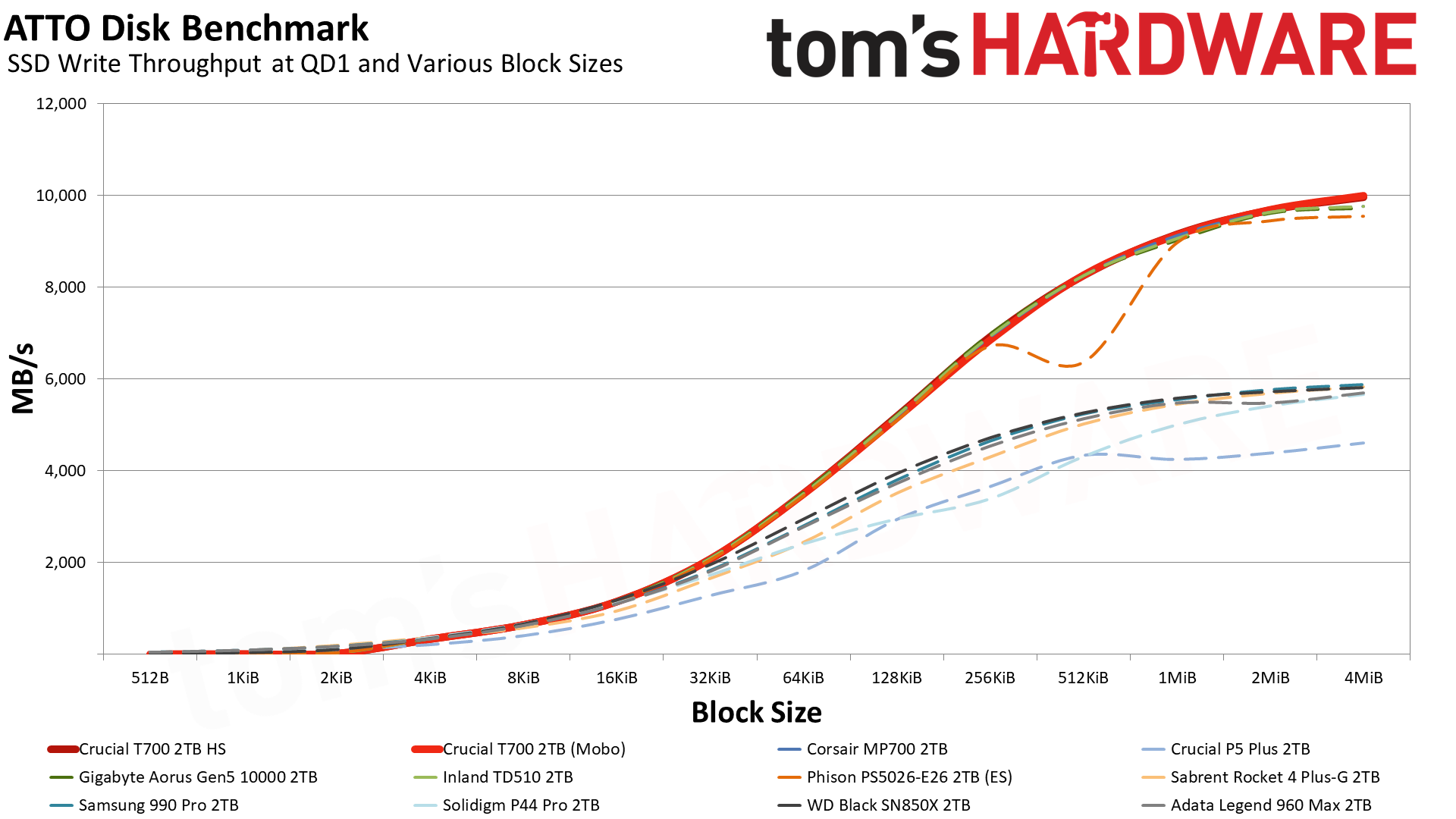


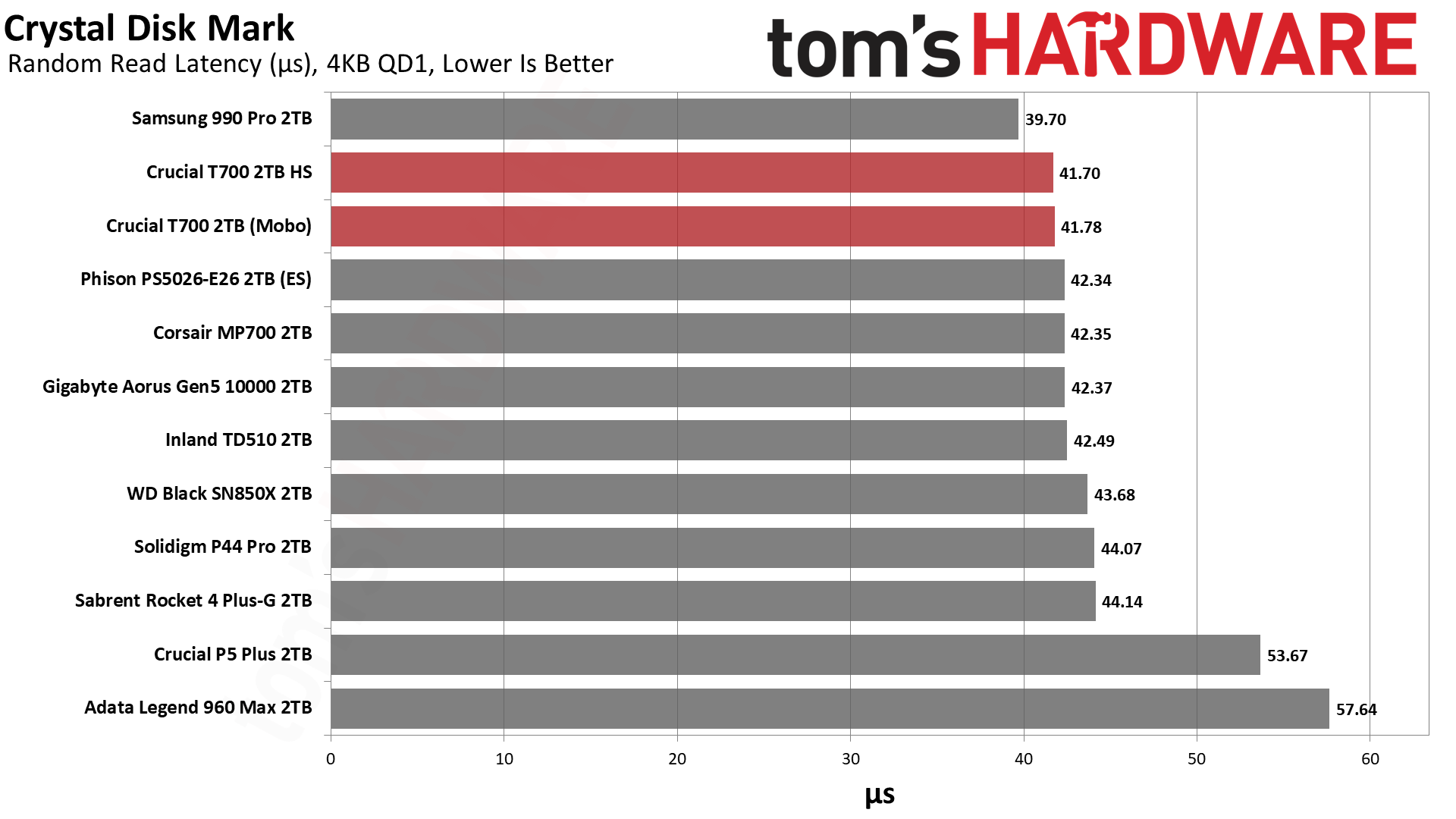
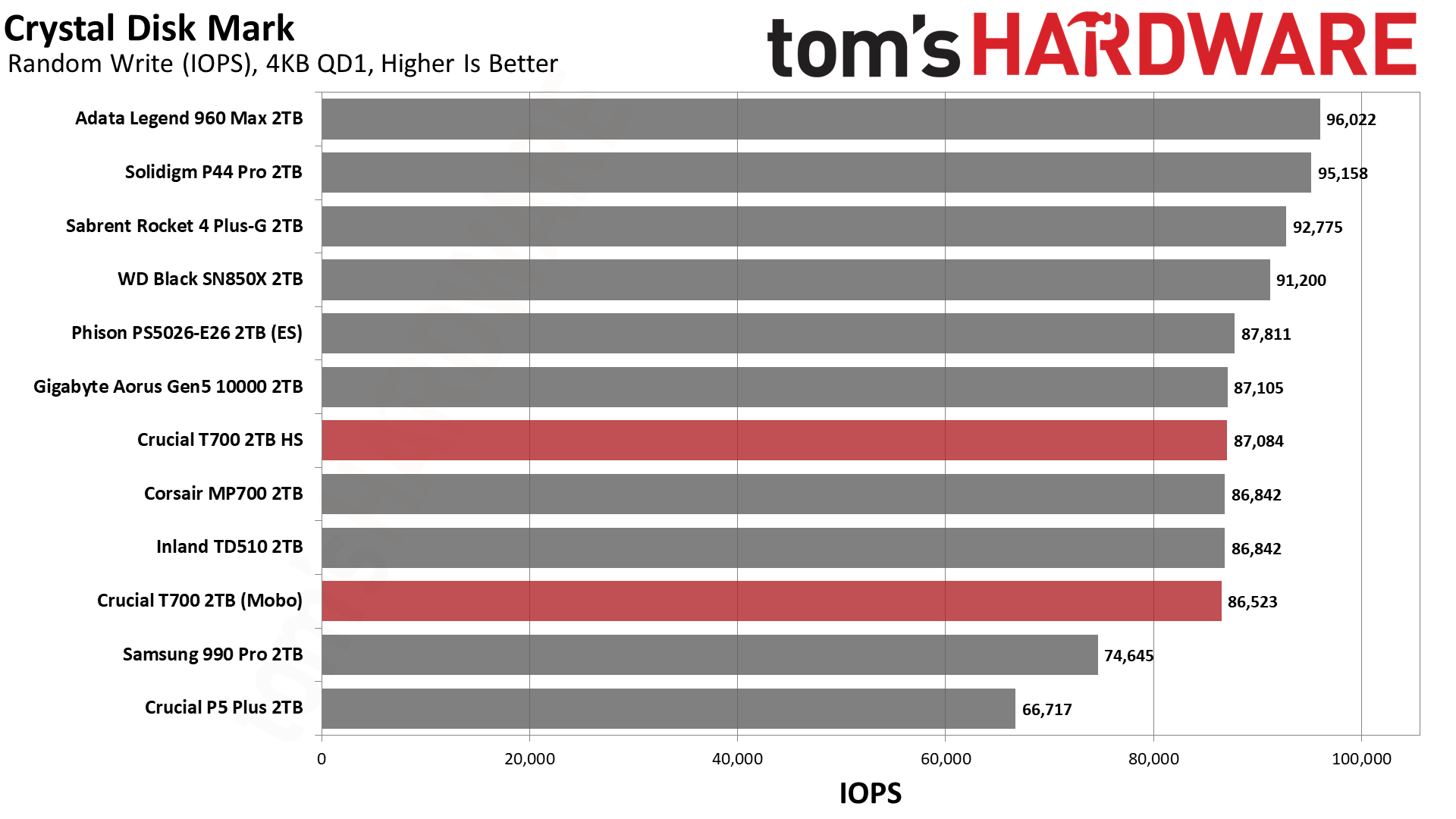

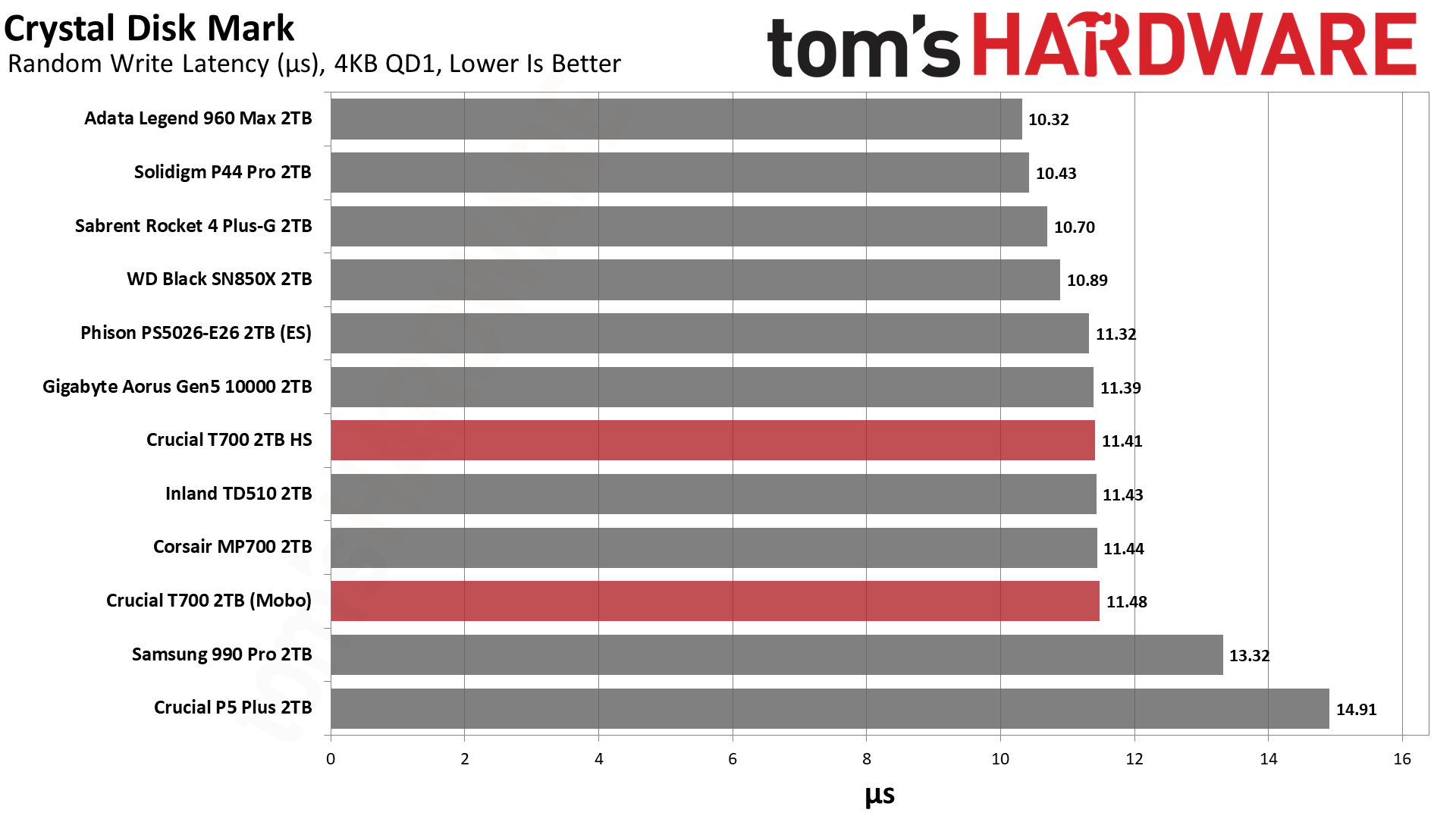
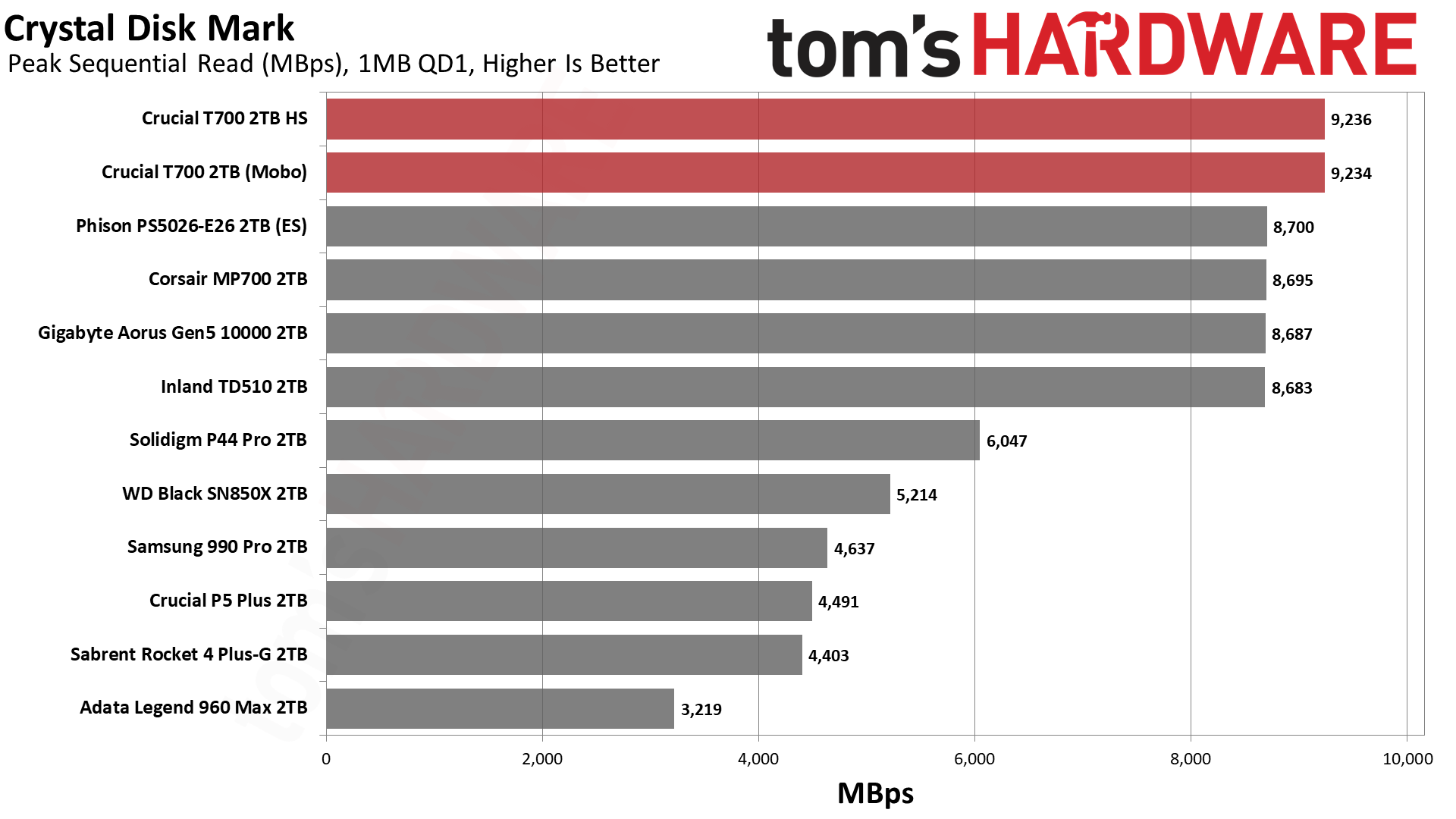
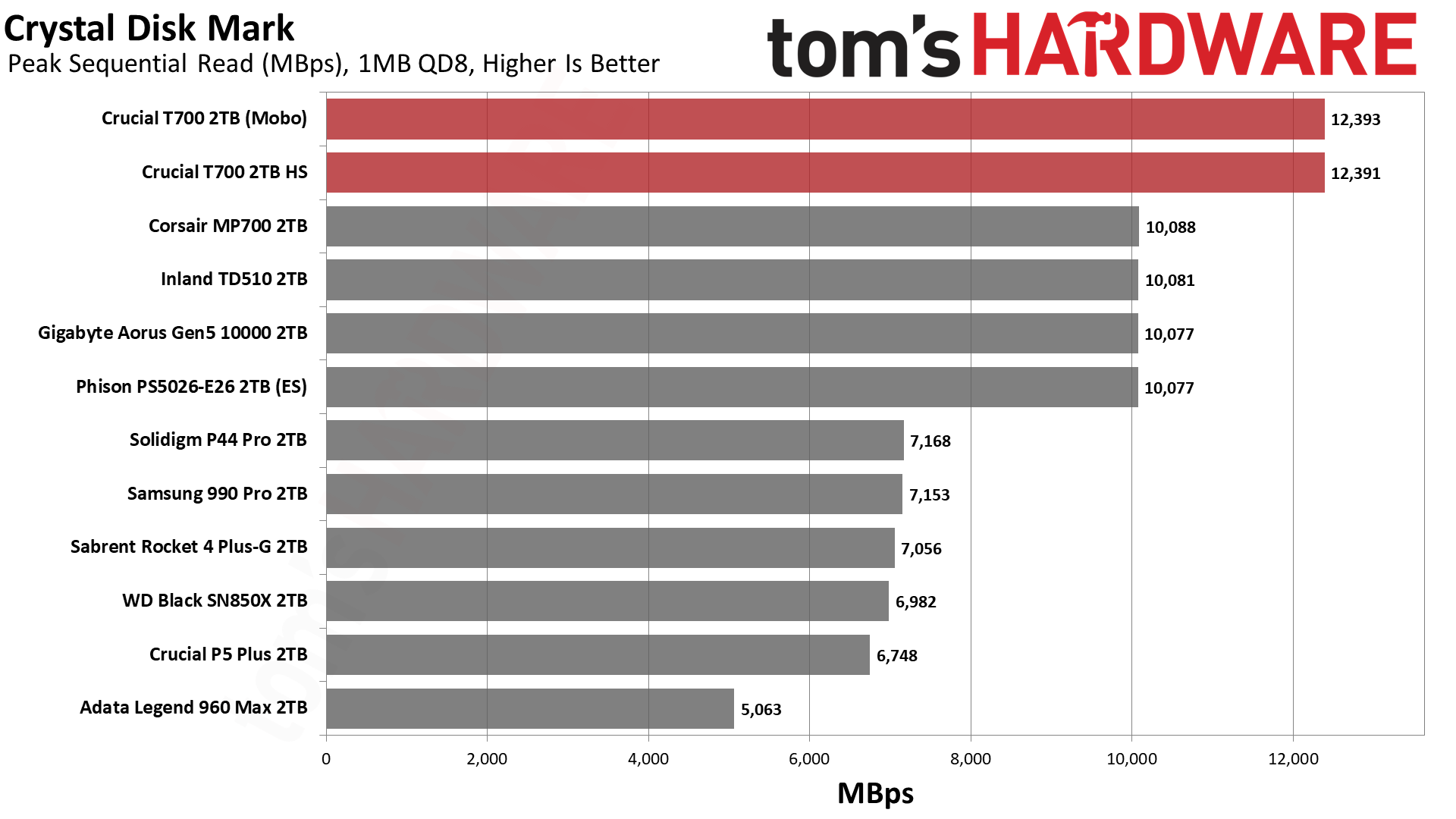


The T700 rules the day in ATTO, particularly as the block size increases past 64KB. There’s a dip at 2MB which, as mentioned in our Crucial T700 Preview, could be a controller quirk or a facet of the flash organization. It's present on the other Phison E26 drives as well for read performance. The T700 also dominates in the CDM sequential results, as expected.
One area the T700 falls short is with random 4KB performance at queue depth 1, still an important result for everyday workloads. In particular, random read latency is critical, and here the T700 comes in second to the Samsung 990 Pro. This is due to Samsung’s 176-Layer TLC having superior read latency. The T700 does do slightly better than previous PCIe 5.0 SSDs, possibly as a small boost from the higher MT/s rate.
Micron’s 232-Layer flash was designed more with density in mind and this may be the case with competing flash to come, which dents the appeal of current 5.0 drives if you’re seeking performance over capacity.
One additional note is that our drives under test are not operating as the primary, or OS, drive. The preview T700 sample had reduced random write performance when used as the primary drive, but this has been fixed for release.
Sustained Write Performance and Cache Recovery
Official write specifications are only part of the performance picture. Most SSDs implement a write cache, which is a fast area of (usually) pseudo-SLC programmed flash that absorbs incoming data. Sustained write speeds can suffer tremendously once the workload spills outside of the cache and into the "native" TLC or QLC flash.
We use Iometer to hammer the SSD with sequential writes for 15 minutes to measure both the size of the write cache and performance after the cache is saturated. We also monitor cache recovery via multiple idle rounds.
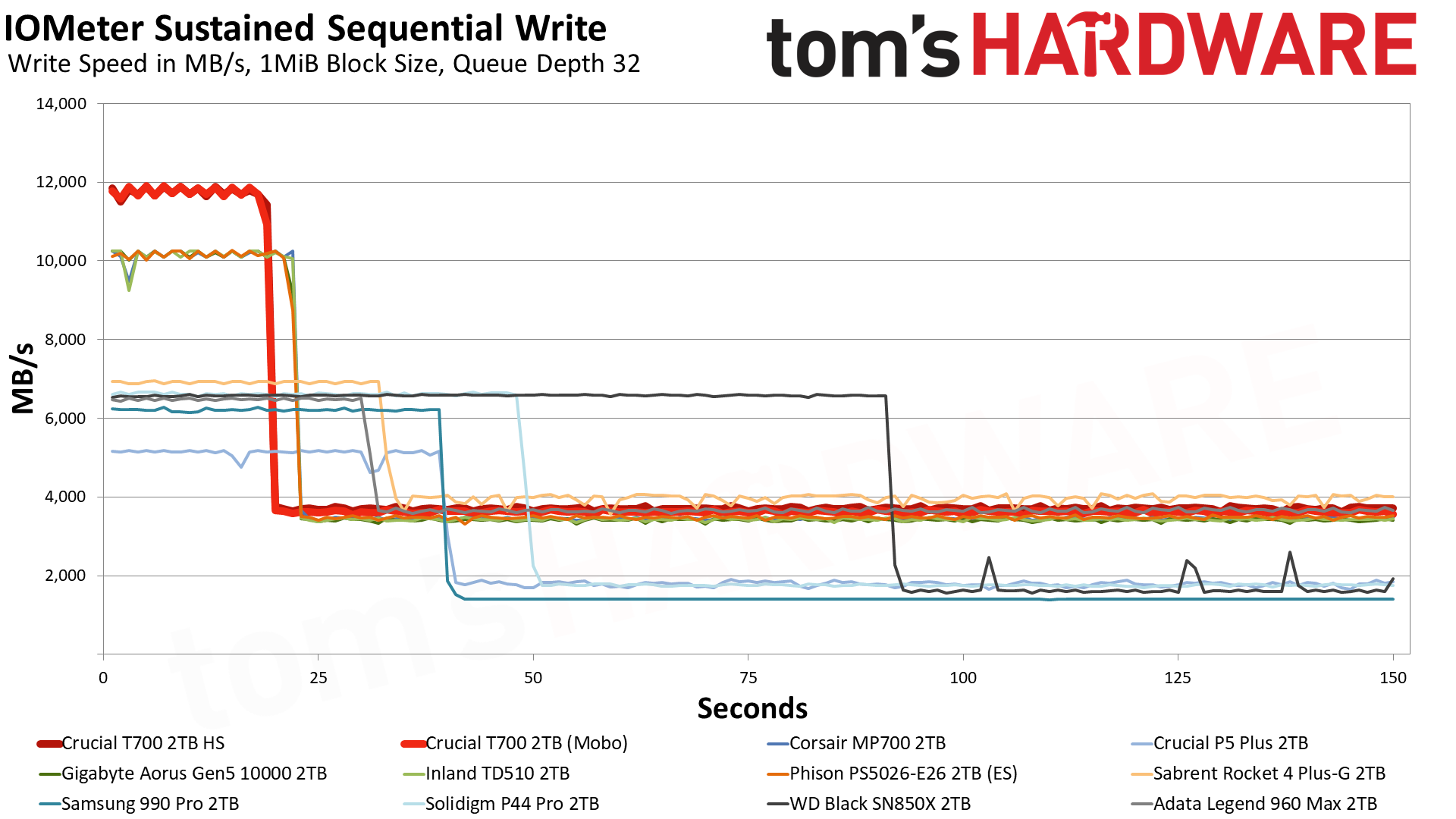


The 2TB T700 writes at up to 12 GBps for over 20 seconds. This matches what Crucial states, which is that about 11% of user capacity is allocated for the dynamic cache. When the drive is empty this is over 220GB from 660GB of SLC, or approximately one-third of the drive’s raw NAND capacity. This is a decently-sized cache to help balance burst and sustained performance even as the drive fills.
The precise pattern of writing will depend on your cooling and the drive’s placement, as demonstrated by the difference between our T700 as native and with a motherboard heatsink. We're testing drives in a PCIe expansion card with the Asus motherboard, and this includes a very large metal cover that serves as a heatsink — far larger than a typical M.2 cooler.
After the cache is exhausted, the T700 writes at around 3.6 GBps in TLC mode. It can maintain this for quite a while before hitting a folding state at around half this speed, and when the cache recovers the drive goes back to TLC. Recovery to TLC performance should be relatively rapid and is adequately fast. This flash should be able to sustain higher levels of TLC performance at 4TB with additional interleaving, but this remains to be seen.
Thermals and Temperatures
We've also begun to collect data on drive temperatures during our DiskBench and Iometer write saturation testing. The latter, as you can imagine, is far more demanding and represents a worst-case scenario. Using the version of the T700 that includes a heatsink during the write saturation testing, it reached a peak temperature of 87C on the controller. At that point, it begins throttling, which is why you see periodic dips in the above write saturation tests around the 850 second mark.
What ends up happening is a short period (less than a second) of reduced performance, then the drive returns to full (saturated) speeds for around 10 seconds. Rinse and repeat until the workload is done.
Please note that this is not a real-world scenario that would normally be encountered by a consumer drive. During our 15 minute stress test, Iometer wrote 2.95 TB of data to the T700. In other words, it more than filled the drive. During the DiskBench testing, where we copy 100GB of files to the drive three times in short succession, drive temperatures peaked at 51C.
Certainly, a larger/heatsink and/or direct active cooling can dramatically drop temperatures. With the large Asus heatsink on the expansion card, peak temperatures during our Iometer testing only reached 54C. This time, due to the lower temperatures and lack of throttling, the T700 drive managed to write just over 3TB of data in nine and a half minutes. The DiskBench tests in this case didn't even break 40C.
Power Consumption
We use a Quarch HD Programmable Power Module to gain a deeper understanding of power characteristics. Idle power consumption is an important aspect to consider, especially if you're looking for a laptop upgrade as even the best ultrabooks can have mediocre storage.
Some SSDs, including all of the PCIe 5.0 SSDs we've tested, can consume a few watts of power at idle while better-suited ones sip just milliwatts. Average workload power consumption and max consumption are two other aspects we'll look at, but performance-per-watt is more important. A drive might consume more power during any given workload, but accomplishing a task faster allows the drive to drop into an idle state more quickly, ultimately saving energy.


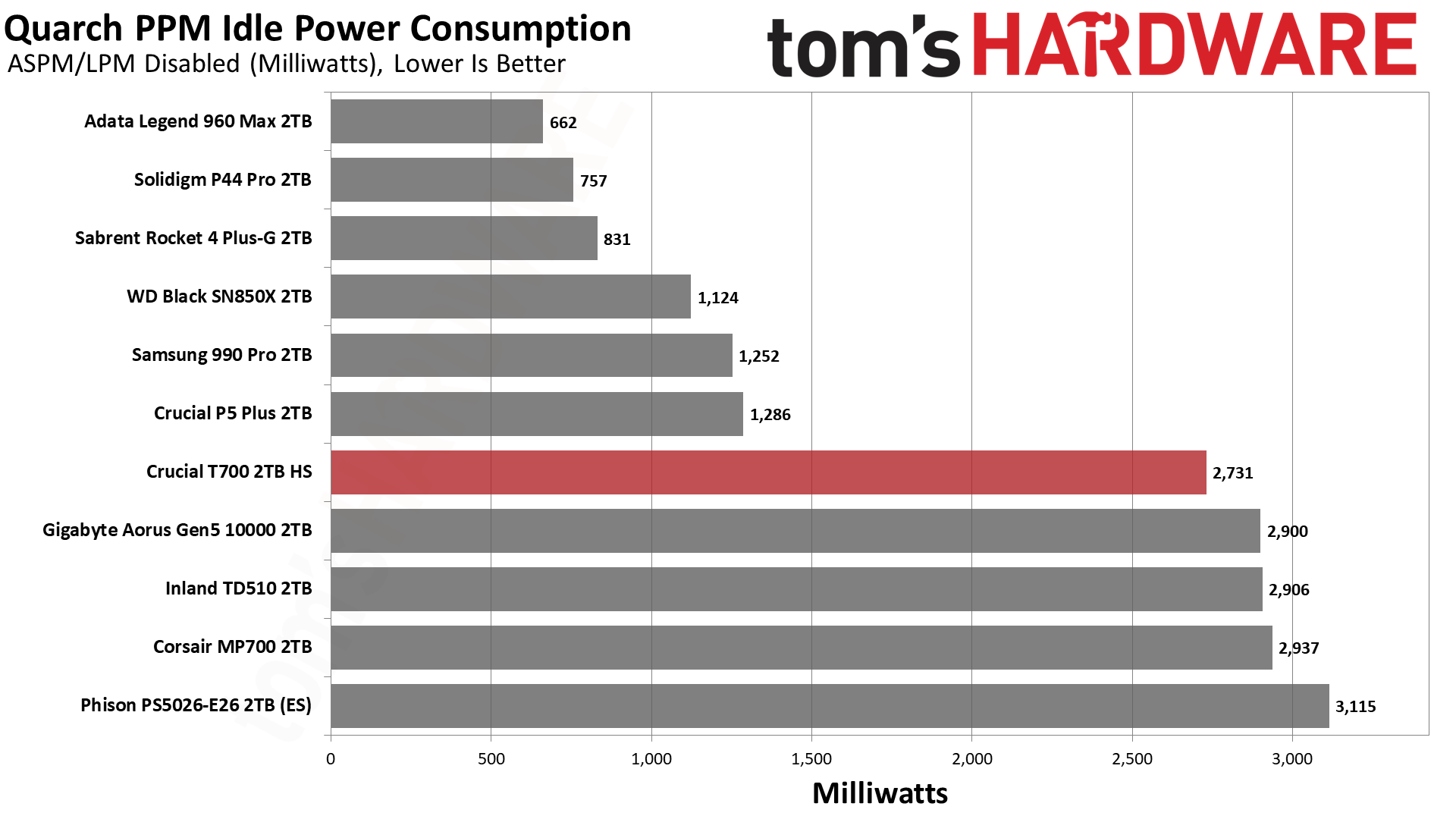
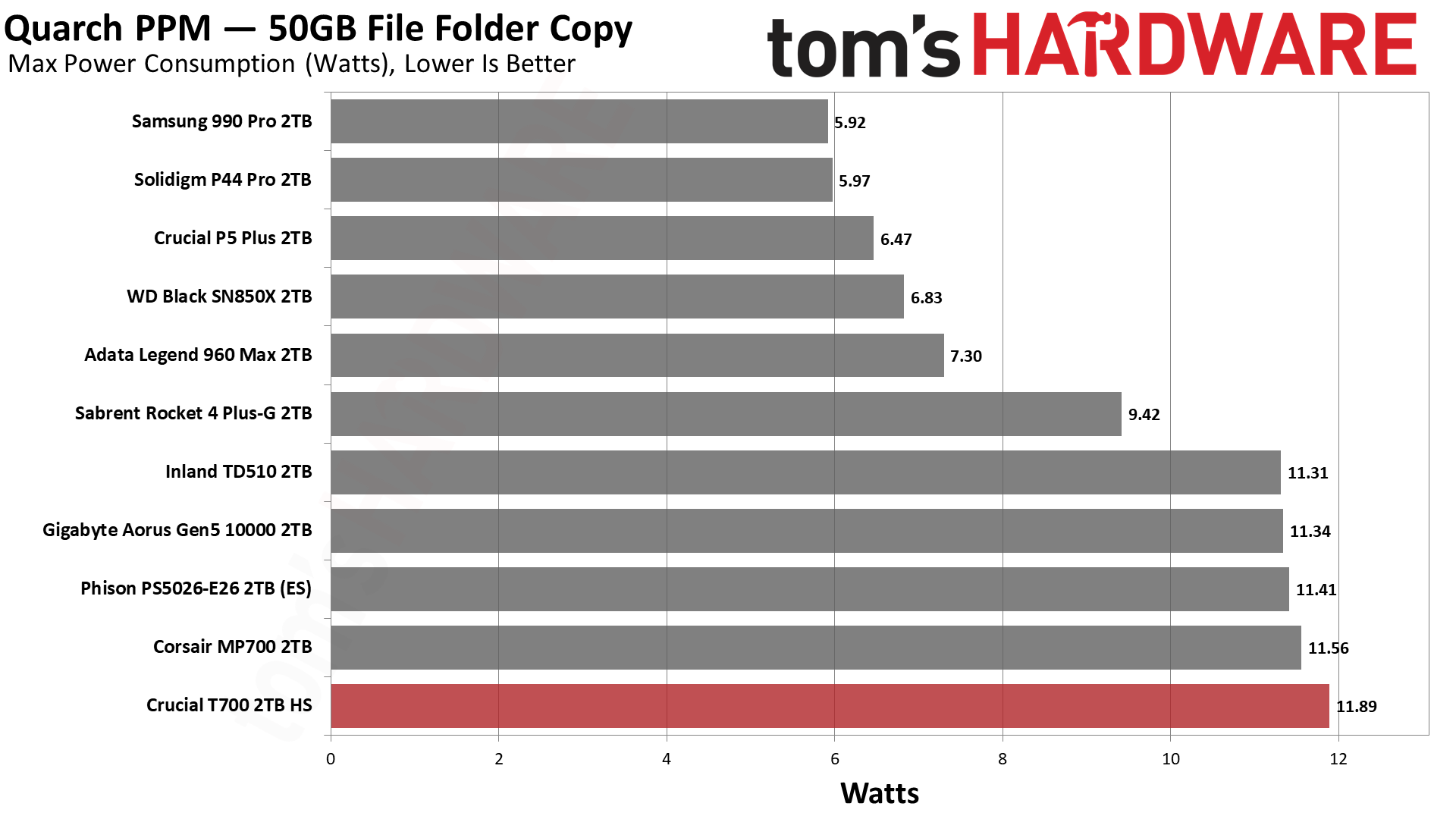
The T700, like the other drives based on the Phison E26 SSD controller, pulls a lot of power. It’s not nearly as efficient as even the fastest PCIe 4.0 drives. This is something that will be ameliorated in time with more efficient controllers and flash. Considering that these 5.0 drives are designed for high-end desktop use only, the issue of power draw is less concerning than it would normally be.
The T700 preview sample had not been optimized for the lowest power states, PS3 and PS4, that is the idle states. This is not a huge factor as the drive should not be making its way into laptops and is hardly a drive you’d choose for a low-power build. Still, the drive at release can use these power states at a typical 85 milliwatts.
Test Bench and Testing Notes
We use an Alder Lake platform with most background applications such as indexing, Windows updates, and anti-virus disabled in the OS to reduce run-to-run variability. Each SSD is prefilled to 50% capacity and tested as a secondary device. Unless noted, we use active cooling for all SSDs.
Bottom Line

The Crucial T700 is the fastest SSD we’ve tested to date. Some minor wrinkles have been ironed out since our preview, and the drive as a whole produced good results. Drives that are just as fast or even faster have been announced, but this one is available here and now. Crucial has gone to great lengths to offer a decent, passive heatsink, while leaving the option open for you to use your own M.2 cooling solution. This makes it attractive in comparison to existing, slower PCIe 5.0 SSDs that use the reference cooler design with a fan, like the Inland TD510.
The Gigabyte Aorus 10000 also has a heatsink option, albeit with less clearance, but that drive is also slower. If you’re shooting for a drive that comes with a heatsink, however, it is currently $30 less at 2TB than Crucial’s price. If you're looking for a sans-heatsink alternative, the 2TB Corsair MP700 is $40 less than the bare T700, although it may be difficult to find in stock. There should be more options after Computex, especially as we get into August with both pricing and availability expected to improve.
The current outlook divides the PCIe 5.0 SSDs into three rough categories: 10 GBps, ~12 GBps, and ~14 GBps (in the future), all for maximum sequential reads but with boosts to sequential writes possible as well. Directly competing in the middle level with the T700 will be the Team Cardea Z540 and the KLEVV CRAS C950, among others. Faster known drives include the MSI Spatium M570 Pro and ADATA’s Project NeonStorm, as well as the IG5666-based Team Group Z54A. More will certainly be revealed during Computex. Pricing and cooling will differ between these options, but ultimately the lower tiers are early adopter products by design.
As for the PCIe 5.0 selling point a drive like this may have, the performance results speak for themselves: For anything but sequential bandwidth, you should go for a much cheaper PCIe 4.0 SSD. Even on a PCIe 5.0 capable board, getting a drive that performs similarly aside from sequential speeds while being much more efficient makes sense — and many 4.0 drives don't require a heatsink. Furthermore, these early 5.0 drives are as slow as 10 GBps with the T700’s 12 GBps currently the fastest available, neither of which make full use of 5.0 bandwidth.
These SSDs need more time to mature. They can be fun for early adopters and enthusiasts that want to set some records. There's still the possibility of higher capacities, not yet realized, which is also nice. If you are already feeding into that mindset with your build then the premium isn’t that crazy, but if you are not hell-bent on cutting-edge storage you should stick with drives like the Solidigm P44 Pro or WD Black SN850X.
This could influence overall system building decisions, and DirectStorage does not currently have sufficient presence to be a factor if you’ll be upgrading again in a year or two, or even three.
That said, the Crucial T700 is nice for what it is, and it’s important that manufacturers keep pushing the limits. Better products at better prices are a net benefit and encourage market penetration of newer storage hardware, which will hopefully hasten the arrival of DirectStorage-enabled games and applications. The T700 is very fast and we applaud it for that today, but we can’t wait to see better things in the future.
MORE: Best SSDs
MORE: Best External SSDs and Hard Drives
MORE: How We Test HDDs And SSDs
MORE: All SSD Content







